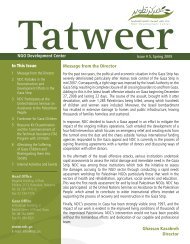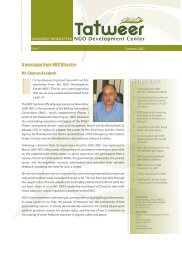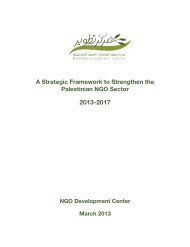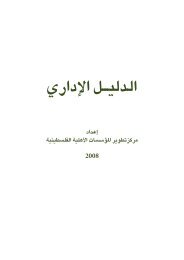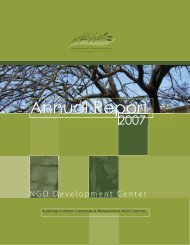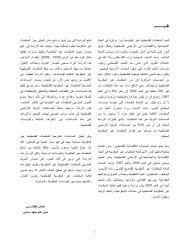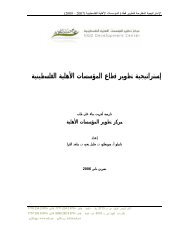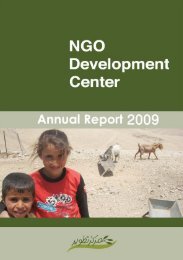Tracking External Donor Funding.pdf - NDC
Tracking External Donor Funding.pdf - NDC
Tracking External Donor Funding.pdf - NDC
You also want an ePaper? Increase the reach of your titles
YUMPU automatically turns print PDFs into web optimized ePapers that Google loves.
3.8.7 In Focus: PNGO Hierarchies<br />
The fact that PNGOs have not distributed themselves along the same lines as donors and contributions does not mean that<br />
those outside of the Central West Bank are forgotten by international aid. The geographical structure of aid, as detailed in<br />
the Figure 40 above, tells the story of a developing hierarchy amongst local organizations. Large professionalized PNGOs<br />
working on a regional or national basis are overwhelmingly located in the Central West Bank. In 2007, 29.6% of NGOs in<br />
the Central West Bank claimed to work at the national level, as opposed to only 4.9% in the north, 9% in the South and<br />
7.8% in the Gaza Strip (MAS, 2007:74). These powerful, nationally oriented organizations act as patrons to smaller<br />
PNGOs or CBOs spread throughout the remainder of Palestine – often serving as conduits of donor aid, capacity builders,<br />
ad-hoc project contractors or oversight and administrative support.<br />
An example of the hierarchy of aid extending to the local level could be when a donor government provides funding to the<br />
Welfare Association, an INGO, who in turn gives money to the NGO Development Center (<strong>NDC</strong>), a Palestinian NGO that<br />
often acts as a donor to smaller local organizations. Among the dozens of PNGO partners of <strong>NDC</strong> is The Palestinian Center<br />
for Peace and Democracy (PCPD), an NGO located in Ramallah who works with and through smaller PNGOs and CBOs<br />
through a network of offices in the West Bank. In such a scenario, there would be three intermediary steps between the<br />
donor and the implementing agency.<br />
3.9 Arab <strong>Funding</strong> to PNGOs<br />
When setting out to track external funding to PNGOs,<br />
the team at MAS worked to better understand the<br />
relatively small percentage of aid arriving from Arab<br />
governments and institutions. The following section<br />
reviews two important reports on Arab funding to the<br />
WB&GS, as well as the findings of our survey.<br />
According to Dr. Malhis (2007), Arab aid to Palestine is<br />
characterized by its solidarity with the Palestinian cause<br />
and liberation movement. From the 1940s until 1967,<br />
remained reactive to the severity of the economic,<br />
political and social conditions in the oPT while lacking<br />
an overall framework.<br />
After the 1967 war, Arab countries’ priorities shifted<br />
from helping in the liberation of Palestine toward<br />
eliminating the war’s effects. Following the 1973 war,<br />
countries gathered at the seventh League of Arab States<br />
Summit where they pledged to give countries 'on the<br />
front line' (Egypt, Syria, Jordan and the PLO) 1.369<br />
Billion USD annually. At the time this represented a far<br />
higher amount than their Western counterparts.<br />
Following the signing of the Camp David Peace<br />
Agreement between Egypt and Israel in 1978, attendees<br />
of the ninth Arab League Summit pledged to allocate 150<br />
Million USD to Palestine annually over ten years.<br />
Although detailed data is not available, the joint<br />
Palestinian-Jordanian Committee reported to have<br />
received around 422.6 Million USD between 1979 and<br />
1985, only 40.2% of the pledged amounts, and 29.5% of<br />
total pledges (10 years at 150 Million USD/yr).<br />
Between 1988 and 1993, following the onset of the first<br />
Intifada, the League of Arab States pledged immediate<br />
support of 128 Million USD to Palestine along with a 43<br />
Million USD stipend per month. However, the onset of<br />
the first Gulf War between the United States and Iraq,<br />
prevented most of these pledges from turning into<br />
disbursements. It is estimated that transfers between<br />
1988 and 1992 totaled to around 103 Million USD, most<br />
of which went to emergency aid and medicines. This<br />
number represents a far cry from the promised monthly<br />
stipend of over 40 Million USD.<br />
The period between 1994 and 2000 saw another shift in<br />
Arab country aid giving, influenced by the Oslo Accords<br />
and the push to support the nascent PA. Between 1994<br />
and 1996, Arab aid reached around 393.4 Million USD,<br />
only about 15.6% of the total aid. The MoP on the other<br />
hand, reports that between 1994 and 2000, Arab aid<br />
totaled 7.3% of total aid to Palestinians 50 . Regardless of<br />
the differences in estimates, both clearly show that Arab<br />
funding was becoming increasingly limited and<br />
marginalized in comparison to its Western counterparts.<br />
Between 2001 and 2007, Arab funding saw a dramatic<br />
rise. Between 3.96 Billion USD was committed as direct<br />
budget support and total commitments reached 5.11<br />
Billion USD.<br />
The major increase in funding followed on the eruption<br />
of the Second Intifada and the intensified occupation of<br />
the West Bank and Gaza. Arab countries convened an<br />
emergency summit in Cairo where they created two<br />
funds: The Al Quds Intifada Fund (200 Million USD)<br />
and the Al-Aqsa Fund (800 Million USD). The following<br />
year in 2002, an additional 150 Million USD was<br />
pledged to those two funds.<br />
However, actual disbursements are different than<br />
pledges. The actual contributions to the two funds totaled<br />
around 761.8 Million USD, representing only 66.2% of<br />
the total pledges. Moreover, of the disbursements made,<br />
89% came from only five countries (Saudi Arabia at<br />
50<br />
It should be noted that the PAMS system and the previous MoPIC<br />
inaccurately captured the data of many multi-lateral instruments<br />
and foundations.<br />
55


